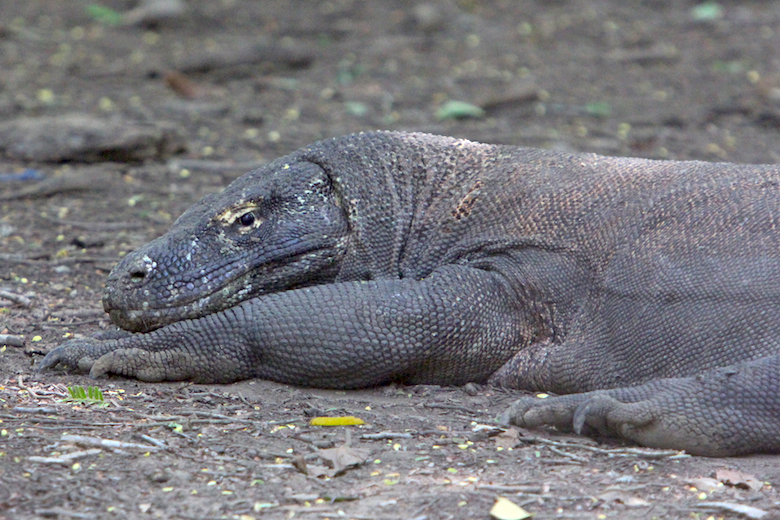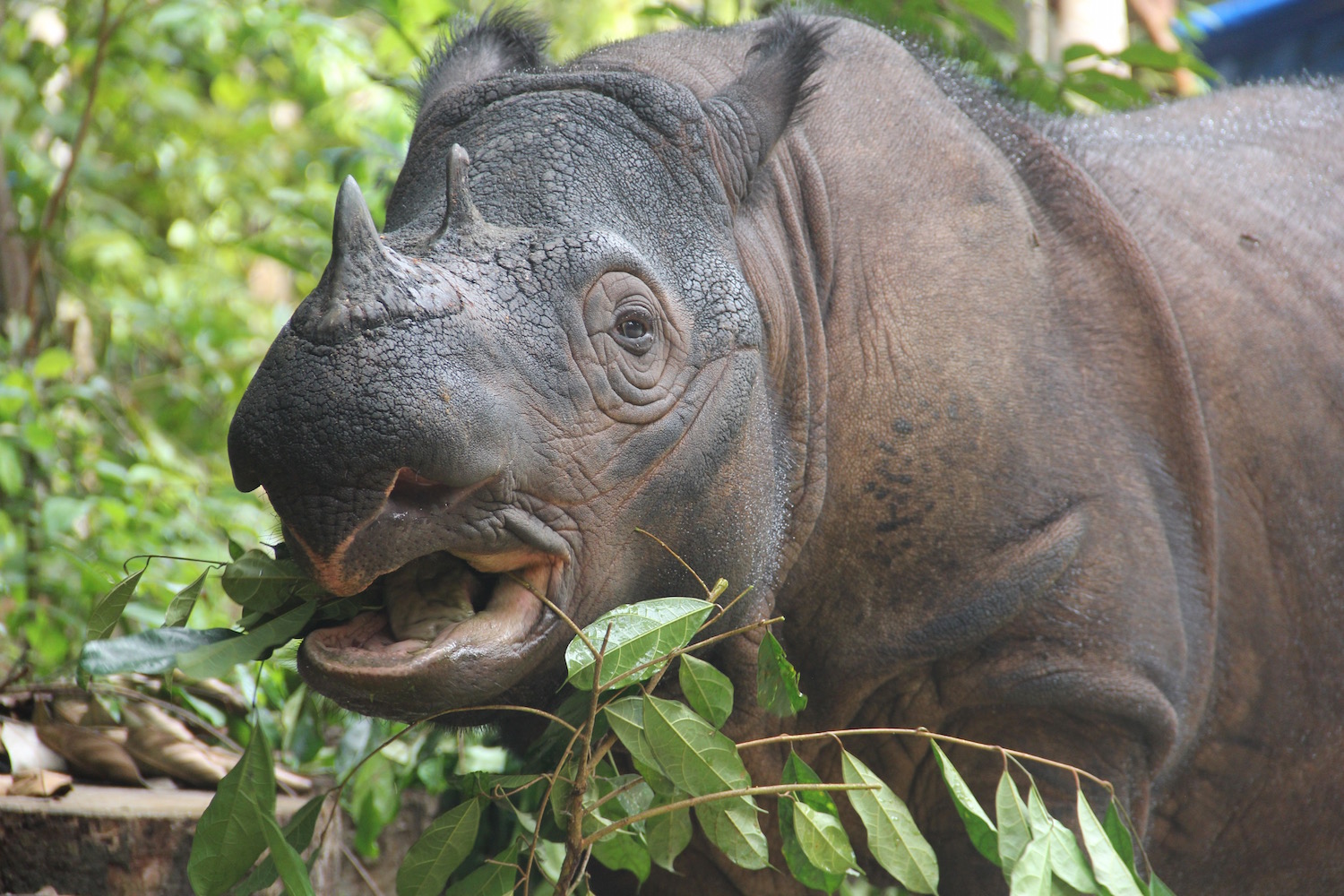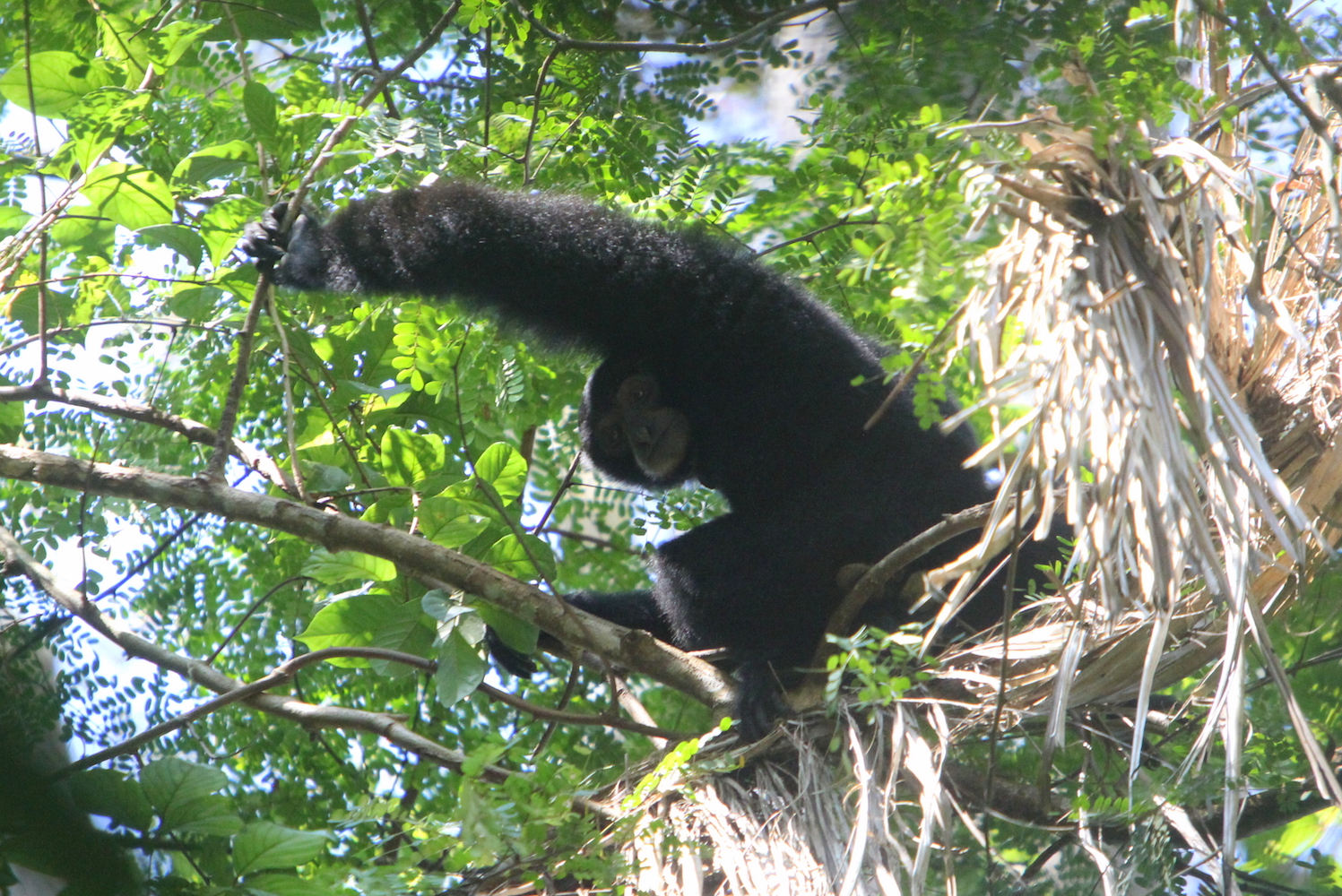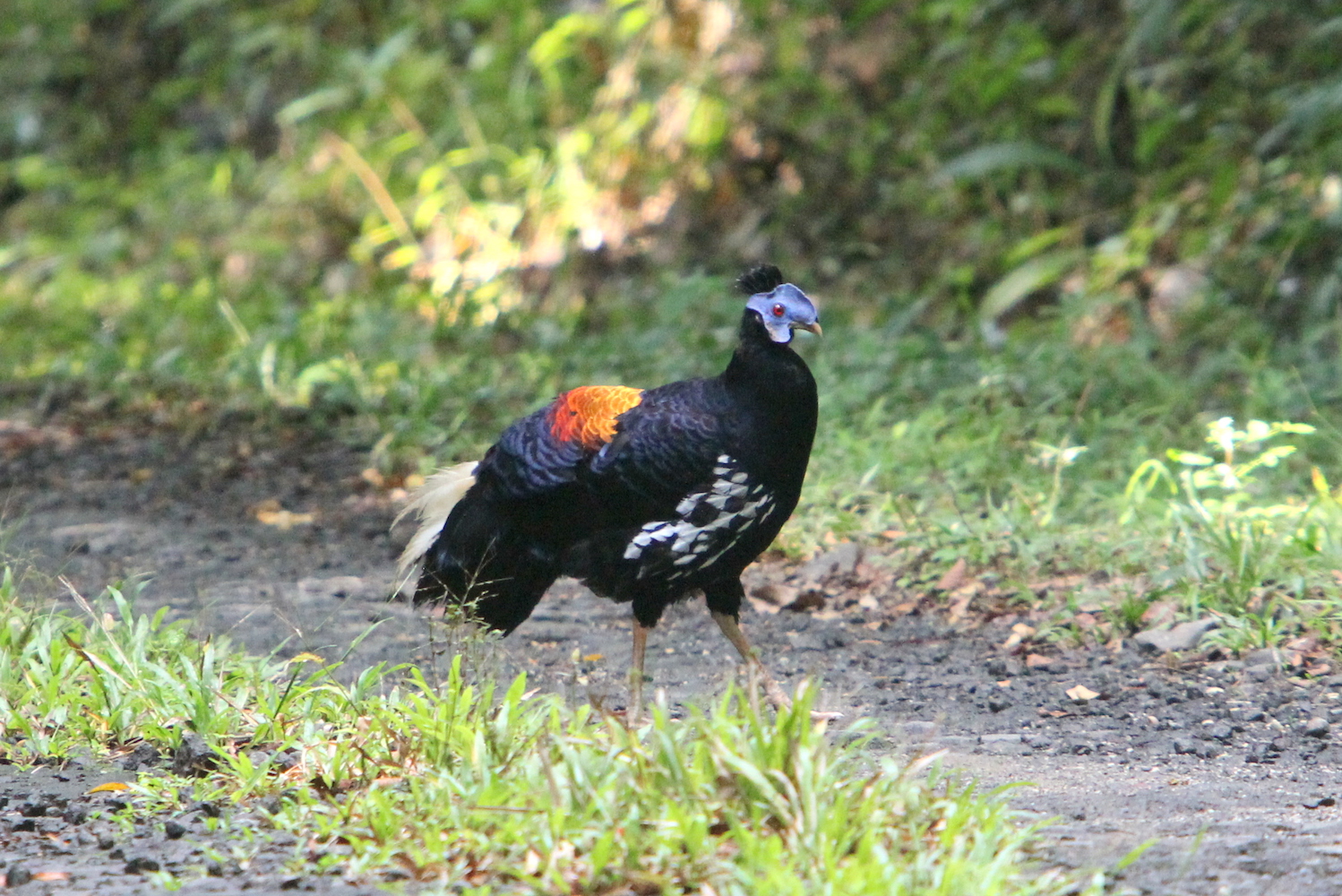
Jeremy Hance with male Sumatran rhino, Andalas, behind him. Photo courtesy of Jeremy Hance.
Jeremy Hance is a freelance journalist with the blog Radical Conservation on the Guardian and a frequent contributor to Mongabay. He has a BA in English from Macalester and a Masters in Liberal Arts from St. John's College in Santa Fe. He has been writing about Southeast Asia biodiversity since 2007, and in 2009, he first was introduced to the plight of the Sumatran rhino. Since then, he has written several articles about the Sumatran rhino, including the Mongabay series "Is Anyone Going to Save the Sumatran Rhino?"
To celebrate the reveal of the ICCB 2019 mascot as the Asian two-horned rhino, also called the Sumatran rhino, SCB held a Q&A session with Jeremy to talk more about his coverage of Southeast Asia biodiversity conservation and the Sumatran rhino.
How did you get started writing about the Sumatran rhino and Southeast Asia biodiversity conservation?
In 2009, I was invited to visit the state of Sabah in Malaysian Borneo for Mongabay – and there I met my first Sumatran rhino, Tam. After just a few minutes with the big hairy lug I was smitten – and it’s been a love affair ever since. Sumatran rhinos are just so weird: they sing, they’re hairy, they’re generally very gentle, and they are evolutionarily distinct from any other rhino. I have a thing for conservation underdogs – I’m obsessed with solenodons for example – so these really bizarre, sweet megafauna just captured my heart. I’ve been lucky to meet six other Sumatran rhinos since and have made a bit of a cottage career in writing about the plight of this nearly extinct wonder. I just hope it helps add pressure for action.
As to Southeast Asian biodiversity in general, I started writing for Mongabay in 2007. The great thing about getting my journalistic start at Mongabay was that I’d be writing about snakes in Malaysia one day and musk ox in the tundra the next. I was covering everything from deforestation to climate change to indigenous people. It was a really wild ride. So, I didn’t really consciously choose to write about Southeast Asia – it found me. And I’m glad it did.
You’ve written many articles about conservation in Southeast Asia for both the Guardian and Mongabay. What do you think are the biggest threats to biodiversity there and what efforts to conserve species in that area do you see as the most promising?
The litany of threats are pretty well known, right? You’ve got some of the highest deforestation records on Earth and you have rising economies that are often bent on development projects that benefit international corporations, but may devastate local communities and the environment. And of course the punches of climate change. In the seas and coastlines, you have overfishing, destruction of habitats, the plastic mess and the evil twins of climate change and ocean acidification.
But underlying all this, you’ve got an unrelenting trade in anything and everything: the trade in mammals, turtles, birds, fish – really all vertebrates and some invertebrates – is absolutely out of control in Southeast Asia. I recently wrote a piece on my blog about the snaring epidemic there – and even for me, who’s pretty used to the gore and horror – it was shocking. The bushmeat trade is bad in South America; the poaching crisis is terrifying in Africa; but nothing compares to Southeast Asia for the numbers of animals targeted and destroyed – and, of course, the global wildlife trade is largely driven by this single region. Probably the most important conservation outcome in Southeast Asia today would be convincing citizens there not to buy wildlife products.
And one thing that’s not talked about enough, anywhere, is overpopulation. Southeast Asia has some one of the highest population densities in the world. Now, of course density isn’t destiny – smart decision-making can mitigate this – but we can’t pretend that more humans don’t strain the environment further and can lead to greater misery.
I’m not throwing stones here. Coming from America, I’m very much aware that there are few nations historically that have done more damage to the global environment – and we now have an administration that is dead set on overturning every environmental protection it can find. Every nation has its demons to face.
As far as promising initiatives in Southeast Asia, I tend to favor small NGOs doing hard, practical work on the ground – maybe again my liking of the underdog. I think the Wildlife Alliance is a good example of a small group achieving a lot. But for all that – given the challenges we’re up against – I think we need to take a more global view as well, but we can get into that later.

A Komodo dragon on the island of Komodo. Photo by: Jeremy Hance
What’s the most important thing you’ve learned about biodiversity conservation through your work?
This is a great question, because it made me stop and think ‘I don’t know!’ I got into this without scientific training, so I’ve learned so many things, wonderful, wild and unbelievable. Hhhhmmmm…but I guess what I would say is that I’ve learned how easy it is to take biodiversity – or putting it less scientifically, life on Earth – for granted.
In many ways, it makes sense. Humans emerged on a planet not only full of species, but a mature biodiversity that had gone through innumerable shifts and regimes. We entered a world of ecological wonder and abundance, so I think it’s really hard for us to actually see how much it matters. It’s overwhelming to try to wrap your mind around all the ecological processes that were required to make your morning coffee, let alone fill the sea with fish. But there it is, and we’ve depended on it since our existence.
We take ecology for granted just as we’ve taken the climate for granted. We’ve assumed that there would be zero consequences for centuries to burning coal and gas buried for eons. We assume – somehow – that we can keep cutting down rainforests and not imperil regional rainfall patterns. We assume we can acidify the oceans, but somehow our children will still have seafood and coral reefs. We assume we can keep using plastics and someone will just clean up the mess.
Obviously, many people are waking up to these issues, but even those of us who are “woke” – to borrow a popular term now days – can’t really wrap our minds about all the interactions and processes that go on every day that makes our world not only livable, but insanely beautiful. The more you see nature, the more you go – whoa, this is just wild. I’m no longer much of a star gazer, because there’s just so much to see down here.

Harapan, a male Sumatran rhino born in the US but moved to the Sumatran Rhino Sanctuary in Way Kambas National Park, enjoys
his lunch. Photo by: Jeremy Hance
There’s been much debate about the best way to try and save the Sumatran rhino, partially due to difficulty in getting the government engaged in its conservation, as highlighted in your series “Is Anyone Going to Save the Sumatran Rhino?” What steps do you personally think need to be taken if we are to save the species?
I’m a little hesitant to divulge my own opinions on this, as I’m currently in the midst of writing about this species again. That said, I think there’s a growing consensus that what’s needed now is more captive rhinos. No one can say with any real confidence that the Sumatran rhino will still be alive in the wild in the 50 years. Hopefully – but maybe not. And if history is any guide existing populations will possibly vanish due to females suffering reproductive problems and having an increasingly tough time replacing old rhinos.
So, with that said – what do you do? The only real choice – other than just to give up, which I’m not willing to do – is to make sure we have a strong captive population.
Today, there are nine rhinos in captivity. But the big kicker is only TWO of these are proven breeders. So to have a chance of success we have to do something that makes many people understandably uncomfortable: we start pulling healthy rhinos from the wild. And we do it now – because we don’t really know how many are left and how soon even the wild populations could collapse. This is the conclusion that most people I’ve talked to have, often reluctantly, come to. No one wants to do this, but more-and-more they see it as the last hope. At the same time, of course, we redouble efforts to protect wild rhinos in the couple places we believe a population may be viable – monitoring and protection can also give us much needed information on the best candidates for capture.
The problem now is the Indonesian government is standing in the way, creating delay after delay. It doesn’t want to act. It hasn’t wanted to really act for years. With all due respect, the government needs to get out of the way and let conservationists do their job. It won’t always be pretty, but it’s our best shot.
The European bison was saved with just 12 founding animals – all captive. Today thousands have been reintroduced in the wild. Long after I’m gone, when my kids’ grandkids are around, that’s the story we could tell of the Sumatran rhino too.
A siamang, the largest of the gibbons, in Way Kambas National Park in Sumatra. Photo by: Tiffany Roufs.
You've been writing your Radical Conservation series for the Guardian for over three years now. What changes have you noticed in conservation between then and now? What do you think (or hope) this series has accomplished?
I don’t think there has been a lot of changes in the last three years – I actually don’t think there’s been a lot of big movement in conservation in the last couple decades. To me this is deeply worrisome.
Having spent nine months looking at the conservation world in 2015 and 2016 for a Mongabay series called Conservation, Divided, I found that a lot of the larger NGOs have decided that the “new conservation” philosophy is the way forward and they are full-steam ahead. And, although some of these ideas are really intriguing, I don’t think they’ve had the impact promised. Now, maybe they will, but the evidence – and there’s been little good research on this but that’s improving – hasn’t borne out the promises.
I think a lot of these groups bought into the neoliberal worldview that the private sector should be the dominant global force – with governments and the public subservient. But that’s created lots of problems and tensions within the conservation movements. I mean you still have well-known, big NGOs partnering with oil companies. That’s insane in an age of rapid, destructive global warming.
Stepping off my soapbox, though, I’ll say there are a couple things that have really grabbed my attention recently. E.O. Wilson’s call for setting aside half the Earth in all varieties of protected and sustainable-use areas is probably the boldest thing I’ve ever heard from the conservation community. And whether you agree or disagree with this particular radical idea, you can’t deny it’s freaking ambitious.
And, I think, if we are to safeguard the natural world for the people of the next century – the next millennium – conservationists and environmentalists need to set a much more ambitious agenda. We need to inspire people not just depress them; we need to learn how to paint the vision of a livable, better world. Alongside this, is the recent discussion of setting up a Paris-like agreement for biodiversity, which I think sounds hopeful. There was a recent paper on this idea, including how to ratchet up funding to save life on Earth. These are the kinds of discussions that are catching my eye.
As to what Radical Conservation has accomplished… Wow, I don’t know. I hope it has done something, but I guess only readers could tell me! This is the thing about journalism: you’re constantly throwing stories against the wall, but you rarely know if anything sticks. On a personal level, it’s been wonderfully fulfilling to have a place where I can write about things that fascinate me.
A crested fireback crossing the road in Way Kambas National Park in Sumatran. Photo by: Tiffany Roufs
What's the biggest challenge writing about wildlife conservation?
I think the toughest thing about writing about wildlife conservation is trying to reach that audience – that journalistic holy grail – that doesn’t generally care about wildlife or wildlife conservation. You have the same problem in climate change coverage. You can write the most incredible piece on climate change, and the only people who read it are those who already realize that climate change is the biggest threat the planet faces today, short of nuclear war.
If I could get non-conservationists to read my articles, I’d be happy as a clam – and not an endangered one, but one of those really abundant, joyful clams. As with anything, a journalist wants their work to matter, to have impact, to change minds and hearts. It’s very hard to do that in environmental journalism, because you’re usually speaking to the converted. Moreover, big media outlets tend to view environmental journalism as a side note. Journalism on conservation issues – such as endangered species or ecosystems – is even more niche. Despite the fact that we’re in an age of mass extinction, very few media outlets – even environmental ones – prioritize conservation. Mongabay and the Guardian, I would say, are two exceptions.
I’m honestly baffled why that is, but if I could figure out why it’s so hard to get people to care, to really do something, about faraway forests and coral reefs and spiders and fungi then I guess we’d solve the global biodiversity crisis.
What do you love most about what you do?
Oh damn, there are so many things. I’ve been really, really lucky. I mean, I’ve gotten to hang out with Sumatran rhinos, spend an evening with a beautiful female solenodon, watch leatherback sea turtles lay eggs, and chase after Javan slow lorises – all in the name of journalism. So I guess what I love most – besides the fact that I can work in my pajamas with my favorite tea listening to Hamilton at full volume – is writing stories that involve getting outside.
Being able to report on a thing in person – instead of just via email and Skype – really changes your view. To touch millennia old peat in northern Minnesota or have coffee with a local conservationist overlooking a Javan volcano shifts your perspective and I think enhances whatever story you’re telling.
Here’s the thing, we live in what can feel like bleak, tough times. Things can feel hopeless. But what’s great about this job – even though I’m often writing about really terrible things – is that I’m constantly meeting people who have devoted their lives to saving a single species or a specific place or confronting a certain challenge. Their entire lives. That to me is amazing. That to me is a sign that humans are not merely a force of destruction, but that we can counter our destructive side with wisdom, humility and compassion – including compassion for the millions of other life forms we share the planet with.
I have a daughter, so I have no choice but to have hope. I’ve also met Sumatran rhinos and solenodons, so yes, yes, yes to hope.

